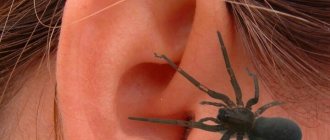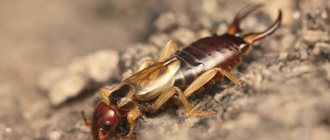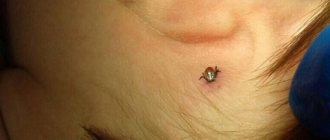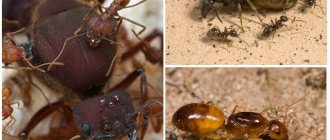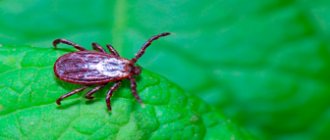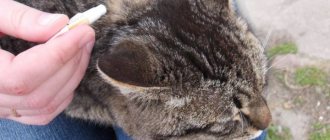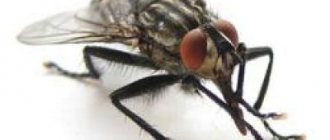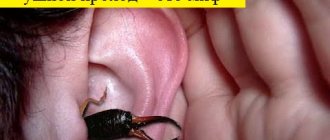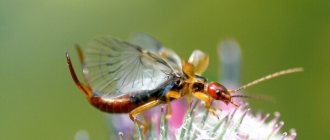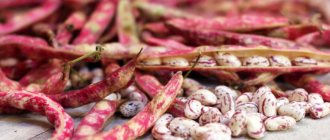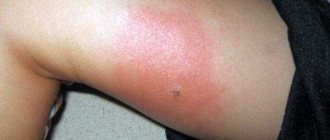To begin with, let's tell you that in many countries, in the same old England, for example, the name has a consonant meaning - “earwig”, which translated into Russian means “earwig”. However, there was probably a play on words in the English language and it is correct to call the insect the term “ear-wing” - “ear-shaped wing” for its specially shaped wings.
One way or another, two-tailed insects crawl into a person’s ear extremely rarely, just like other insects: bugs, ants, bedbugs and other cockroaches. And for those who have not yet understood what we are talking about or want to admire it again, we present a photo of an earwig.
Description of the double tail
Double-tailed
Two-tailed animals are small arthropods from the order of cryptomaxillary hexapods . Their ancestors lived millions of years ago. Two-tailed birds live in tropical climates; out of 800 species, about 30 are found in Russia.
The body length of most species is 2–7 mm . It consists of a head capsule and an abdomen, divided into 11 segments. At the end of the abdomen there are 2 appendages (cerci) . They can be long, thread-like or short, claw-like. Since two-tails do not have eyes, their functions are performed by the cerci.
The mouth is hidden in the head capsule. There are long antennae located in front of the head. On the initial segments of the abdomen there are 3 pairs of jointed limbs.
The body is bi-easted and light in color . Due to their inconspicuous coloring, small size and hidden lifestyle, they are hardly noticeable. They live in moist soil and humus, in damp fallen leaves. Life expectancy is about a year.
Description of the earwig
Earwig
The earwig (mite or pincer) is an omnivorous insect pest from the order Leatherwing . It has an oblong and flattened body of medium size, up to 2–50 mm in length, covered with a durable chitinous shell.
The color of the insect is red or dark brown , the shade is lighter on the head and legs. The shape of the head is heart-shaped, sloping down. It is separated from the body by a square pronotum.
On the front of the insect's head there are long antennae, reaching 2/3 of the body in size. They consist of 11–14 segments. The eyes are small, it seems that they are completely absent.
The abdomen is segmented, at its end there is a pair of mandible appendages. In shape they can be thread-like or curved like pincers (forceps) . In males, unlike females, they are larger and jagged on the inside. Females have pincers that are shorter and almost straight.
If you touch an insect with your hand, it will arch the back of its body, put its claws forward and may bite . Because of this, the earwig is popularly called the pincer . The insect does not have poisonous glands; instead of poison, when in danger, a foul-smelling liquid is released.
Most earwig species have 2 pairs of wings . The front pair are short, leathery elytra of a dark brown or dirty yellow color, tightly fitting to the body. The hind legs are wide, membranous. Despite the presence of wings, the insect rarely flies. Because of their structure, the earwig rises vertically into the air, folding its membranous wings twice upon landing. They should fit completely under the front leathery elytra.
The insect moves mainly with the help of its legs . They are a running type of pest and are well developed.
The common earwig is widespread throughout the European part of Russia . In this species, males are larger than females - 17 mm in length. Females grow up to 14 mm. Less common is the coastal earwig . In nature, it is found in sandy soil near water bodies.
Features of the life of earwigs
The insect loves warmth and moisture and often settles next to humans in rural areas. It is found in leaf litter, in compost heaps, under stones, fallen trees and near water bodies. Settles in residential buildings.
The insect is nocturnal - it hides in a shelter during the day, and crawls out at night in search of food. It is most active in cloudy, windy and rainy weather with minimal fluctuations in night and day air temperatures.
The pest reproduces in spring and early autumn . Mating lasts several hours. The male and female move back towards each other until their rear ends touch. After 2 months, the fertilized female lays white-yellow oval eggs in previously prepared burrows . She, alone or together with the male, makes a tunnel in the soil 5–15 cm deep with an expansion in the form of a chamber at the end.
It is there that the earwig lays 30–60 eggs in the fall and 20–30 in the spring. The female earwig is a caring mother; she remains near the eggs, rarely leaving the hole . Protects and turns eggs, providing the offspring with the most comfortable conditions. During this period, females are the most aggressive and bite the most painfully.
The earwig is an insect with an incomplete development cycle - from larvae it turns into an adult (imago) bypassing the pupal stage.
After spring mating, larvae appear 3 weeks later in May-June. They reach sexual maturity by the end of summer. During this time, the larvae molt 4 times. From eggs they emerge similar to adults, but smaller in size, gray-brown and without developed wings. With each molt, the insect's integument darkens and all parts of the body gradually form. Warm weather promotes rapid maturation of the insect.
During autumn fertilization, the eggs laid overwinter in the soil, and the adults crawl into burrows and hibernate.
The insect feeds variedly , eating living and rotting leaves and plant stems, the pulp of vegetables, fruits, bee bread and honey, pollen, lichens, and algae. From animal food it prefers the larvae of various insects, including pests: mites, aphids, caterpillars. Can eat bee larvae and the remains of large insects.
Why is an earwig dangerous?
The earwig is omnivorous. It gnaws out all parts of plants: leaves, flowers, berries, fruits, roots, unripe seeds and young shoots . First it leaves holes, then it completely destroys the leaves and damages the stems.
The pest is dangerous both in open ground and in greenhouses. The insect damages cereal plants, corn, cabbage, cucumbers, melons, pumpkin, legumes, beets, celery, tomatoes, and potatoes.
On fruit trees, the earwig looks for fruits that are overripe, weak, or already damaged by other insects and birds. Willingly eats peaches, apples, pears, cherries, plums, and cherries.
It deprives many flower crops of their decorative value: chrysanthemums, roses, carnations, dahlias, asters, phlox, poppies.
The pest can settle in beehives, houses and non-residential buildings . He opens honeycombs and loves to feast on honey . It is found in clothes and underwear, makes its way to food, and can crawl into bread and the refrigerator.
In addition to plant foods, it eats animal foods. Prefers other insect pests with soft covers. It is impossible to determine how much such benefit outweighs the harmful activity.
Economic importance of earwigs
Earwigs, being a small group of insects in terms of the number of species, have relatively little economic importance compared to the rest of the order complex. However, this group still includes a number of species that have a certain and sometimes very significant economic importance for individual crops and economically valuable plants.
The most significant role is played by 3 types of earwigs - the Asian earwig, the garden earwig and the common earwig. As for the first species, it is a pest of the seeds of the wild rubber plant - tau-sagyz in the Karatau mountains in southern Kazakhstan, which is currently a significant source of seed products necessary for planting plantations of this very valuable rubber plant. The harm is expressed in the gnawing of stigmas and pistils in flowers or sometimes in the complete eating of ovaries in young buds.
The garden earwig, on the contrary, is an extremely polyphagous pest, which is especially significant for garden crops (potatoes, beets, soybeans, poppy seeds, sunflower seedlings, cabbage, tomatoes), as well as for melons (cucumbers, pumpkins, melons), tobacco and floriculture, causing damage both in the larval and adult states by gnawing leaves, gnawing stems, or even completely consuming seedlings and young plantings. In addition, this species is noted as a pest of sugar beet seeds in Ukraine, gnawing out semi-ripe seeds. Climbing into weak apple fruits, the earwig can also cause some, but insignificant, harm.
The common earwig harms garden plants and floriculture in Ukraine and Western Europe, eating living leaves, flowers and semi-ripe seeds. In addition, this species is important for corn and other cereals (semi-ripe seeds are eaten) and fruit trees. Having been introduced to North America, the common earwig species even became a quarantine object due to the severe damage it caused to nurseries of ornamental and other trees. In New Zealand, where this species was also introduced, it became the scourge of local fruit growing. In addition, there have been cases of this type gnawing out passages in baked bread.
From all this it should be concluded that the order of earwigs is not a group of insects indifferent to humans. Their economic importance can sometimes be so significant that the absence of certain control measures can jeopardize the yield of damaged crops.
How to get rid of earwigs in your home and yard
Chemical and biological drugs
Karate
The contents of the 1 ml ampoule are first diluted in 1 liter of water, then the volume of liquid is adjusted to 10 liters. The product is used in calm weather at an air temperature not higher than 35°C and humidity up to 65%.
Inta-vir
Insecticide of enteric contact action without a pungent odor. Quickly affects the nervous system of the pest. The protective effect lasts 10–15 days.
To spray leaves, 1 tablet of the drug is dissolved in 10 liters of water. For treating indoor plants, the consumption rate is 1 g per 1 liter of water.
Spark
Active, odorless insecticide for spraying plants in the garden, vegetable garden, greenhouse and home. Consumption rate – 1 tablet per 10 liters of water. First, the drug is diluted in 1 liter of warm water at a temperature of 35–40°C. Then the working solution is diluted with the remaining water. Fruit and berry plants cannot be processed during flowering and fruiting. The pest control drug is used before budding or after harvesting.
For indoor prevention, use the insecticide Iskra golden in the form of sticks. Depending on the diameter, one pot will require from 1 to 6 pieces. If the pests have already appeared, then a solution of 1 ml of product and 2 liters of water is prepared for spraying.
Iskra BIO is used for greenhouse plants . This emulsion is effective in hot weather at air temperatures above 28°C. 2 ml of the drug are diluted in 1 liter of water.
Dichlorvos
A broad-spectrum intestinal pesticide, the death of the pest after treatment is 95–100%. Before use, the can of the drug is shaken and sprayed in insect habitats.
If the treatment takes place in a room, then the windows and doors are closed, and after the procedure is completed, the room must be ventilated 2 hours later. When spraying, there should be no food, animals, or children nearby.
Raptor
Universal insecticide in aerosol form. Before treatment, shake the can and spray areas where insects accumulate for 6–8 seconds. The drug is convenient to use in hard-to-reach places: behind cabinets, in narrow wall openings.
Fufanon
The active substance of the drug settles not only on the leaves and shoots of plants, but also spreads in the air, enhancing the effect due to fumigation. The insecticide does not change the taste and smell of the fruit. Consumption of the product for treating vegetable and fruit crops: 5 ml per 5 liters of water, for ornamental plants in the garden and in the house - 1 ml per 1 liter of water. The protective effect lasts 5–10 days.
In the house, as well as in the area where insects accumulate, they are treated with any insecticide. In the fight, you can use chalk "Mashenka" from cockroaches . Having determined the habitat of earwigs, mark this area with chalk: corners, baseboards, ventilation holes.
Traditional methods
- A solution is prepared from garlic to kill the pest. 200 g of cloves are poured with vegetable oil for a day. Then the concentrate is filtered and 2 tbsp is used to spray the plants. l per 1 liter of water. For greater adhesion, laundry or liquid soap is added to the solution.
- Insects do not like the smell of vinegar, onions, wormwood, tansy, and mint. You can repel them by soaking rags in substances that are unpleasant to the pest. In the house, corners, floors and baseboards of rooms are sprayed with these infusions.
- Bait is prepared from boric acid. 1 boiled egg yolk and 50 g of boric acid are mixed, rolled into balls and placed where the earwig was noticed.
- Set up a simple earwig trap by filling an empty jam jar or flower pot with straw or scraps of paper. Stick a pole into the soil and place the jar or pot upside down among the tops of the plants. Adult earwigs will not resist the temptation to take refuge in this shelter for the night. In the morning, before they become active again, shake them out of the trap away from your plants or near aphid-infested plantings.
- In the house, earwigs are caught by placing wet rags and sponges in the bathroom and kitchen overnight. The collected insects are taken away from the house and destroyed.
- In the garden and vegetable garden, when digging the soil, a cluster of insects is poured with boiling water.
Preventive measures
General preventive recommendations include:
- Installation of mosquito nets on window, doorways, ventilation openings. It wouldn't hurt to seal any cracks in the walls, if any.
- Maintaining cleanliness of the room: thoroughly dry rags after cleaning, regularly throw out garbage and wash the trash can, and keep the floor clean.
The main preventive measure against double east is solving the problem of high room humidity. Otherwise, removing earwigs without a trace will be very problematic.
Video - review of the use of the chemical drug Medilis Cyper for the destruction of two-horned:
Earwig bite. What to do?
The earwig bites humans with its claws only for the purpose of self-defense if it is accidentally stepped on or picked up. The bite is painful, the damaged area itches and swells . In case of danger, instead of poison, a brown, foul-smelling liquid is released .
With a deep puncture, a small wound is formed and blood flows. The bite site should not be scratched; it should be washed with soap and water and wiped with an antiseptic .
It is a common belief that earwigs often crawl into the ear of a sleeping person . Such cases are rare. If this happens, then a few drops of hydrogen peroxide or vegetable oil are placed in the ear so that the insect crawls out. If you cannot get rid of the earwig, then go to the hospital.
General value
According to the dream book, double tails are a contradictory symbol. The main interpretation of an unsightly creature is hypocritical behavior, blatant lies
Moreover, what has been said can relate both directly to the observer and to his immediate, especially important, surroundings
Other transcripts are less common. The two-tailed thing that appears in a dream means:
- Problems with the kids. Images of earwigs are often interpreted as childish. The sleepy destruction of creatures is a projection of the observer’s real hostility towards his own offspring;
- Minor, but extremely troublesome troubles. In the dreamer’s life, a huge pile of unresolved problems grows, leading to depression and uncertainty;
- Future diseases, disorders, physiological troubles. A positive sign is the complete destruction of two-easts: in reality you will be able to quickly recover;
Listen to your intuition. A premonition will indicate the meaning of the subconscious image and will help you correctly interpret what you see.
